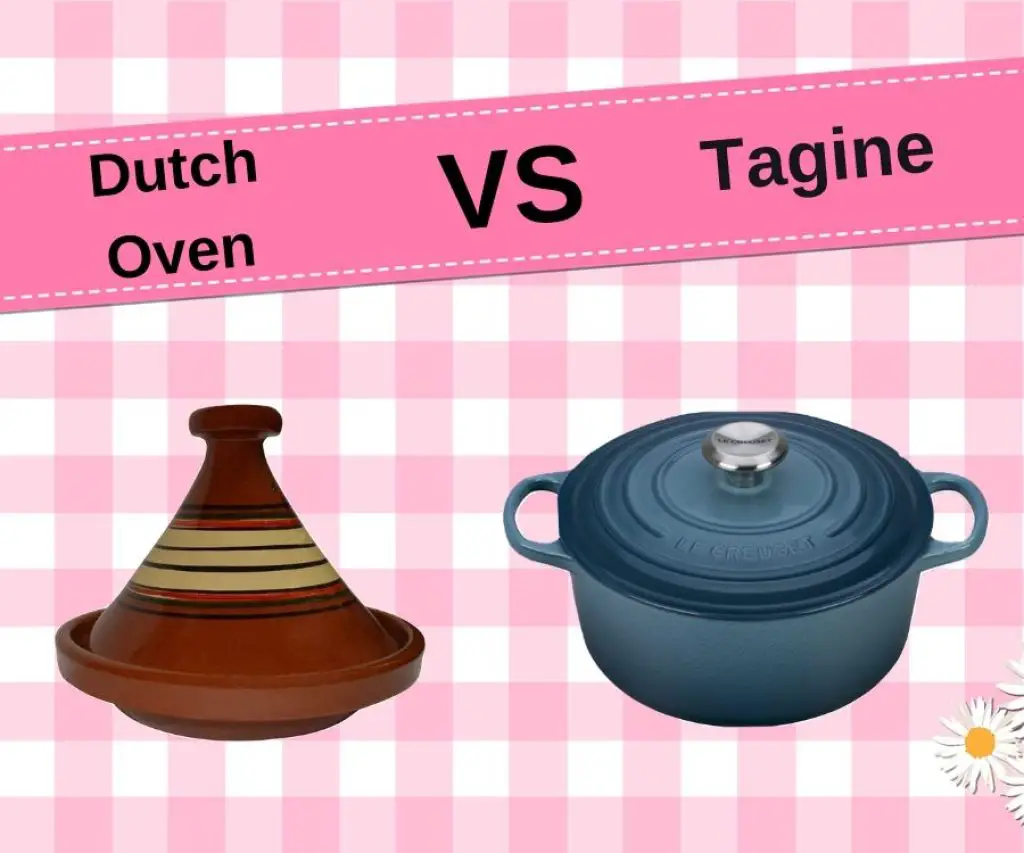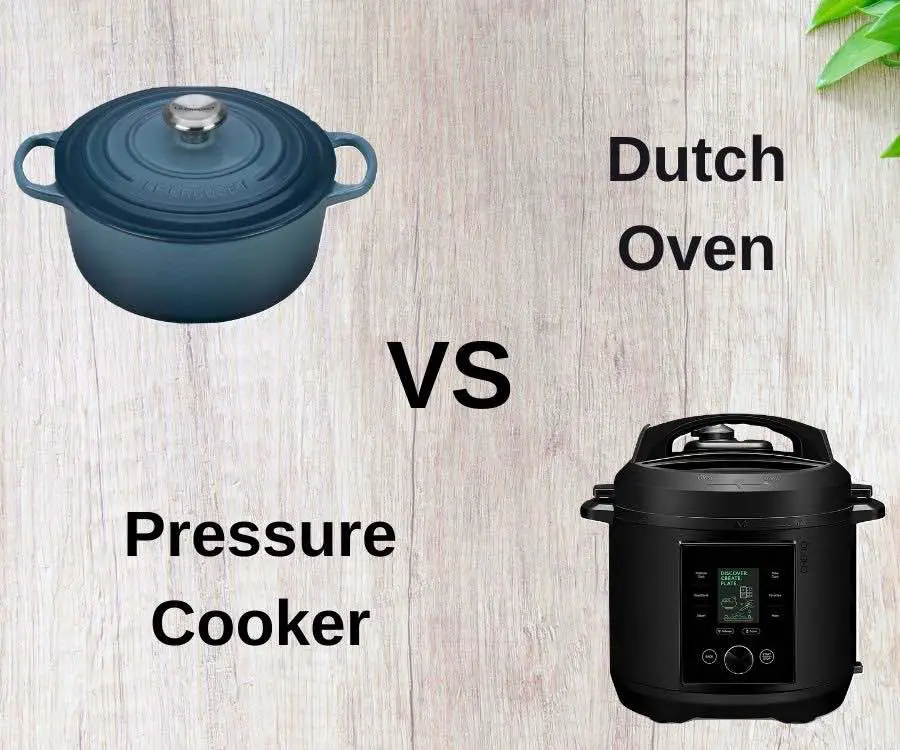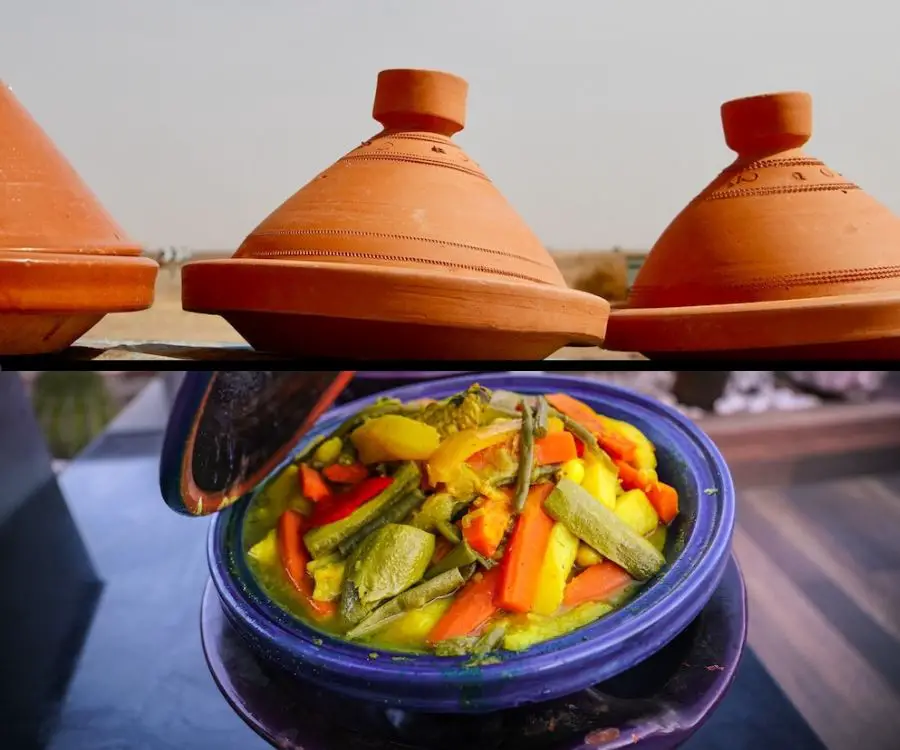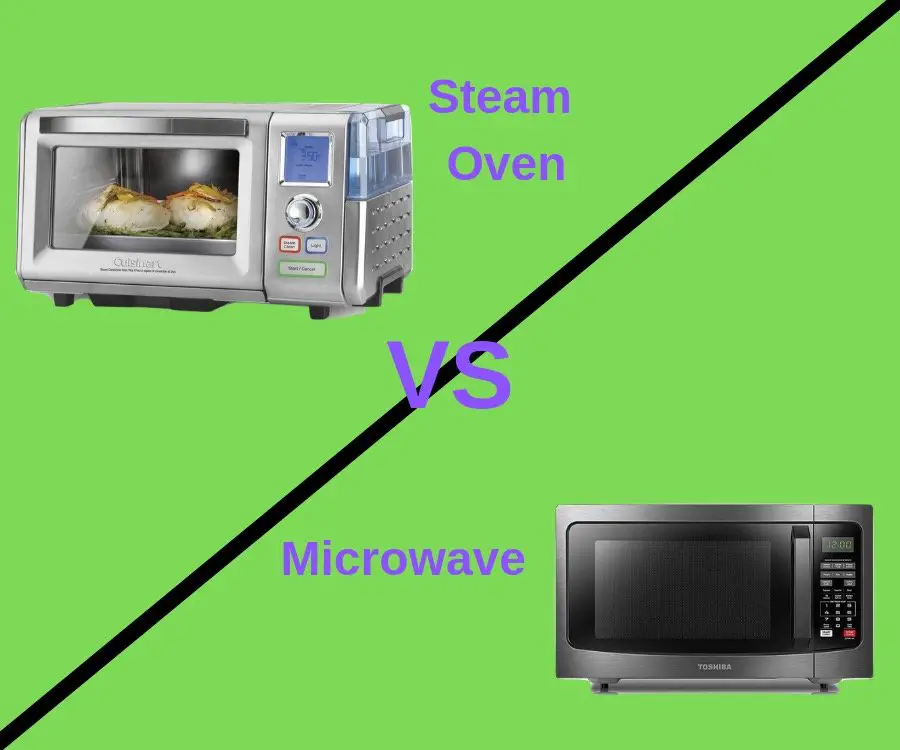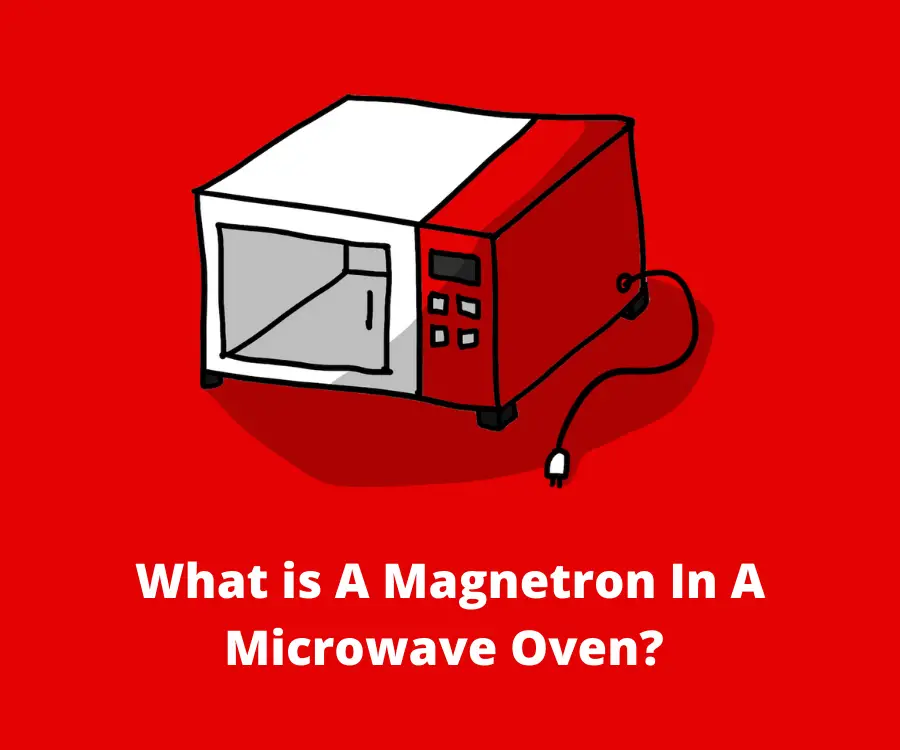As I’m getting more and more into cooking, I’ve been discovering and comparing a whole range of appliances and cookware. I was interested in finding out the differences in Tagine vs Dutch Oven, and once I’d looked into this I put together what I found in this post.
So what are the differences in Tagine vs Dutch Oven? A tagine is a cooking dish made from clay, although you can buy aluminium and cast iron tagines. Meals cooked in tagines are called tagines. A dutch oven is usually enamel coated cast iron, and can be used for roasting, frying, boiling and soups. Both can be used on a stovetop and in the oven.
The above paragraph is the answer to the question of tagine vs dutch oven in the most simple terms. There is of course much more to it than this.
I’ve tried to compile as much information as I could find such as how they work, differences in size and cooking time, and advantages and disadvantages of both. I hope you find this information useful.
Tagine vs Dutch Oven (What is the difference?)
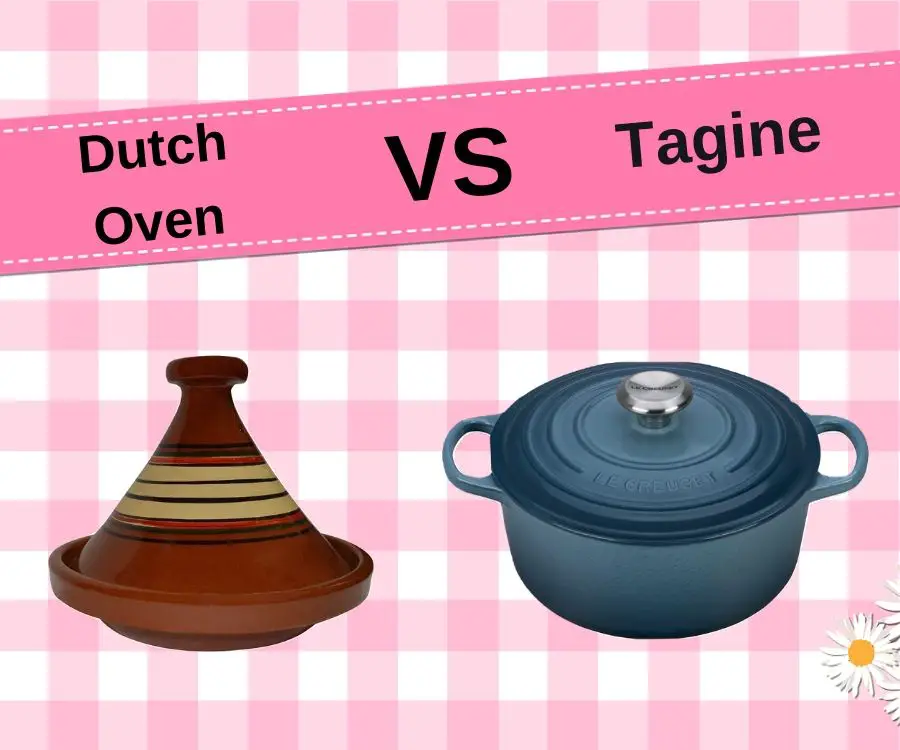
When looking at these two cooking vessels, the thing that struck me most is the similar approach to cooking. Both rely on cooking over long periods of time.
They both also work on trapping and using steam and moisture to cook food radiantly. This gives them both the ability to cook meat really tenderly.
Whilst the above shows us how they are similar, there are of course some notable differences too.
Later on we will have a look at differences in size, price, and the advantages and disadvantages of both. First let’s take a look at how they measure up against each other in terms of functionality and how they actually work.
How Does a Dutch Oven Work?
A dutch oven is a cylindrical cooking pot. It is made of cast iron or is ceramic, and coated in enamel. The lid of a dutch oven is tight fitting, locking heat and moisture firmly inside.
It is this retention of moisture that is the key to cooking with a dutch oven. Radiant heat passes through the food whilst cooking in a moist environment. You can cook meat with an extremely tender consistency with a dutch oven.
You can also use the dutch oven to cook on both a stovetop and inside the oven. This is another appealing feature of this piece of kitchenware. You can begin cooking on the stovetop and transfer directly to the oven. It saves on washing up!
Probably the main selling point of a dutch oven is it’s versatility. As I said you can cook with this both on the stovetop and in the oven. You can use it to cook in a variety of ways. I have listed a few of these below:
- Roasting
- Frying
- Making soups
- Casseroles
- Stews
- Bread making
As you can see, the dutch oven is versatile indeed! Who would have thought that not only could this be used to make soups and casseroles, but you can also roast and fry with it and make bread too!
How Does a Tagine Work?
One of the great things about a tagine is that it can also be used both on a stovetop and in an oven. In contrast to some other cooking appliances, using a tagine is not a quick process.
The tagine cooks food in a similar way to a dutch oven and slow cooker. A tagine is conical in design, and the lid works to trap steam inside. The hot, steam filled environment ensures that food is cooked evenly, and cooks food full of moisture.
The base of a tagine is wide and shallow, and as she steam rises inside the conical shape at the top, it condenses and then falls back down.
You must be careful when using a tagine directly on a stovetop due to the material used to make them. Originally tagines were made of raw clay, and if this type of tagine is placed on a stovetop it will crack and will then be unusable.
You can buy both glazed and unglazed clay tagines. If you are cooking with a clay tagine you should place a heat defuser between it and the stovetop.
Cooking at lower temperatures for longer periods of time is desirable when using a tagine. If you cook at too high a heat you will again risk a tagine made of clay cracking due to thermal shock.
You can of course buy tagines made in a range of materials these days, such as cast iron, stainless steel and ceramic. The same rules don’t apply to the kind of heat this sort of tagine can take. Whilst you gain the higher heat capacity, many will say that you lose the earthy feel and taste provided by cooking with a raw unglazed clay tagine.
You should cook food at low temperatures for long periods. Allow the food to slowly simmer and then leaving for 2 to 3 hours depending on the recipe is the best way to use your tagine.
Difference In Size Between A Dutch Oven And Pressure Cooker
When I am looking at buying things for my kitchen I always want to know about size. I have a fairly small kitchen and so I always want to make sure I am buying appliances that I know I have room for.
Both dutch ovens and tagines come in a variety of sizes and materials. Which one you go for is really down to personal preference. You have to factor in:
- The size of your kitchen.
- How often you plan to use it.
- How many people you plan to cook for.
- Your overall budget and what you are willing to spend.
Let’s take a quick look at some of the different sizes of both. Hopefully this might help you decide which one is right for you.
Dutch Oven Sizes
Originally dutch ovens were cylindrical in shape. However these days you can also buy round, square and rectangular dutch ovens. There is little to no difference in the functionality of these different shapes.
Dutch ovens, as with other appliances such as pressure cookers are measured in quarts. A quart is a unit of measurement which is equal to a quarter of a gallon or 2 pints. Dutch ovens can range in size from 1/4 quart to around 15 quarts.
A 15 quart dutch oven is going to be pretty big, and maybe you would be looking for something smaller. Below is just a rough guide as to hat to expect from these different sized dutch ovens:
- Under 2 quarts – You will use this for making individual sides such as mac and cheese or delicious small desserts such as creme brulee. This is going to be best for individual portions. If your kitchen is tiny, this will be perfect.
- 2-3 quarts – Depending on the contents, you can expect to get maybe 3 to 4 servings with a dutch oven of this size. This size is great for cooking rice and pasta dishes. Will still fit in a reasonably small kitchen.
- 3-5 quarts – You can expect to get approximately 3 to 5 servings with dutch ovens of this size. If you are a family of say 2 to 4, this is ideal for making one pot dinners.
- 5-6 quarts – This is what most people feel is the ideal dutch oven size. You can expect to get between 5 and 7 servings with a dutch oven of this size. It is versatile and can cook many different meals and combinations of foods.
- 6-10 quarts – This is obviously going to be much bigger. You can expect to get between 8 and 14 servings with a dutch oven of this size. Great for making large batches of soup and stew too!
- 13-15 quarts – This is most ideal for catering for large dinner parties. You can expect to get between 15 and 20 servings using one of these dutch ovens. Bear in mind that it will take up a lot of space in your kitchen! If your kitchen is small like mine, or if you live alone this is not the one for you.
Tagine Sizes
When I was looking into tagines, the measurements I could find seemed to be in centimetres rather than in quarts. So below is a very short guide as to the size of a tagine, and how many people you can expect to cook for with it.
The below is assuming that you are cooking your whole meal in the tagine. If this is not the case, and you are cooking something to go with it separately such as couscous, you can add another two people to the numbers I have used.
- 25 centimeters (approx. 10 inches) – This size of tagine will really only cook for one person. It will be small enough for even the tiniest of kitchens. This would also be great for making starters.
- 27-30 centimeters (approx. 11 to 12 inches) – This size of tagine will cook for approximately 2 to 3 people comfortably.
- 32-35 centimeters (approx. 13 to 14 inches) – You can expect to be able to cook for between 4 and 6 people with this size of tagine. Obviously the diameter is starting to get a little bigger!
- 37-40 centimeters (approx. 15 to 16 inches) – A tagine of this size should comfortably cook for 7 to 8 people. That huge diameter is going to take up a lot of space in your kitchen though!
Difference In Cooking Time Between A Tagine And Dutch Oven
In a previous post I looked the differences between dutch ovens and pressure cookers. There was a clear difference when comparing these. Dutch ovens cook slowly with radiant heat over a longer period of time, whereas a pressure cooker relies on high pressure to cook quickly.
When looking at tagine vs dutch oven in terms of cooking time, these will obviously be a lot closer. There is no definitive answer here, as it really depends what you are cooking, and how many people you are cooking for.
Most people will be using a dutch oven in the same way as most use a slow cooker. For this reason in comparing the two I would say that you would be looking at longer cooking times with a dutch oven compared to a tagine, although a raw clay tagine does require a lower temperature.
Tagine vs Dutch Oven – Differences In Price
How Much Does A Dutch Oven Cost?
When I looked at dutch ovens to purchase one, I noticed a huge variance in price. Obviously size makes a big difference to price here. Also some of the more established brands are a bit more on the expensive side.
Below are just a couple of examples at opposite ends of the market:
The Lodge EC6D43 Enameled Cast Iron Dutch Oven is a great choice and won’t break the bank. It is available in a number of sizes ranging from 1.5 t 7.5 quarts, and starts under the $60 mark. If you are just starting out then something on the cheaper end would be ideal for you to dip your toe in the water.
If price isn’t a problem for you, there are some really expensive dutch ovens out there. I guess you get what you pay for, and this Le Creuset LS2501-246MSS Signature Enameled Cast-Iron Round Dutch Oven certainly fits into that category.
This 4.5 quart oven comes in a number of colors, and is made by Le Creuset, regarded as the best when it comes to dutch ovens. Like I said it’s pretty pricey, and you can check the price here.
How Much Does A Tagine Cost?
As with most things, there is a real variance of price when looking at buying a tagine. A lot can depend on the size and material it is made of. I’ve provided just a couple of examples below:
This Moroccan Tagine, by Kook, has a ceramic lid, cast iron base and is 2.5qt in size. it is at the cheaper end of the market, but gets great reviews on amazon. You can check the price here.
At the other end of the market you have this beautiful tagine made by Emile Henry in France. It is a 3.7 qt tagine, although it does also come in others sizes and colors. You can check out the price here.
 Advantages and Disadvantages Of Cooking With A Dutch Oven
Advantages and Disadvantages Of Cooking With A Dutch Oven
Dutch Oven Advantages
I’m not going to lie, I love dutch ovens. The versatility you get with them is amazing. There are many advantages, and not so many disadvantages.
- As I mentioned above, the sheer variety of cooking methods is such a plus point. You can:
- Roast
- Bake
- Fry
- Make soups and stews
- Make casseroles (and this list is not exhaustive)
- You will need to clean up less, being able to use a dutch oven both on the stovetop and in the oven.
- Dutch ovens are also very simple and easy to clean.
- Food cooks thoroughly due to the even radiant heat spread throughout the contents of the dutch oven.
- If you look after your dutch oven properly it can last for many years due to the hard wearing nature.
- If seasoned properly they won’t rust, and are virtually non-stick.
- Due to the tight fitting lid, you can cook food packed with moisture!
Dutch Oven Disadvantages
As I said above, there is not much to dislike about the dutch oven. Really the only thing I could come up with was how expensive they can be. However, if you buy a really great dutch oven it can last for so long that it is worth the money anyway!
Advantages and Disadvantages Of Cooking With A Dutch Oven
Tagine Advantages
As with everything (although maybe not so much the dutch oven), tagines come with their advantages and disadvantages. I think cooking with a tagine takes time to perfect, and so you should be patient when first starting out. Below are some of the advantages I have found when researching cooking with tagines:
- The pot seals in moisture whilst cooking to allow for really tender meats and food full of moisture.
- If you go for an unglazed tagine, many people say that the food cooked has a wonderful earthy taste to it.
- Depending on the tagine, you can use it as a serving pot, cutting down on washing up! It also looks really classy.
- You can use the tagine on all types of stovetop, as long as you use a heat diffuser, and in the oven too.
Tagine Disadvantages
I’m not really sure if I would describe the below as disadvantages of using a tajine. I think they are just things you need to think about before buying:
- If you buy an unglazed tagine (which I think is best), you will need to season it before use. You can read how to do it in this post.
- Cleaning an unglazed tagine is a little more complex than cleaning something like a dutch oven.
- A tagine is less versatile than a dutch oven, which is fine if you are buying it with a specific purpose in mind.
Conclusion
So tagine vs dutch oven and the differences between them. As you can see there are similarities between the two, especially when it comes to how food is cooked. Both cook food slowly, using radiant heat and maintaining moisture. Both therefore will cook food that is both full of moisture and also tender.
Whereas a dutch oven gives you much more versatility in terms of dishes that can be cooked, and methods to cook them, an unglazed tagine will cook traditional Moroccan tagines with that real earthy feel and taste.
I hopes you found this read interesting, and it gave you something to think about in choosing between tagines and dutch ovens. If you have any questions, or would like to leave a comment then please do so below. I will get back to you as soon as I can.
Thanks for reading.

